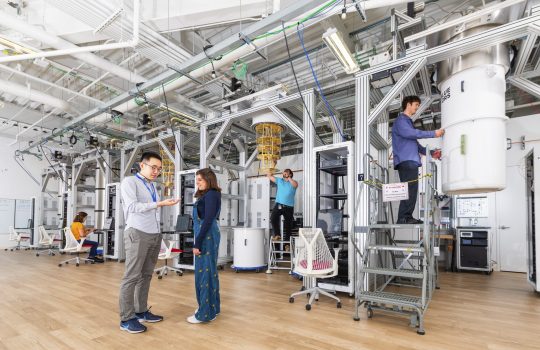On Oct. 1, Deputy Secretary of Energy Dan Brouillette and members of the U.S. Secretary of Energy Advisory Board visited the Department of Energy’s Fermilab to see first-hand its world-class facilities for exploring particle physics, accelerator science and technology, and quantum science.
The distinguished group included Congressman Bill Foster, Deputy Secretary of Energy Dan Brouillette, and retired Lockheed Martin Chairman and CEO Norm Augustine.
The VIP guests heard about the international Deep Underground Neutrino Experiment, hosted by Fermilab, and its Long-Baseline Neutrino Facility; the PIP-II accelerator project; the lab’s contributions to the LCLS-II accelerator at SLAC National Accelerator Laboratory; the laboratory’s efforts in superconductivity-based qubit technology; and Fermilab’s suite of neutrino programs, including the ICARUS experiment.
“I’m always amazed at what our national labs are accomplishing, and Fermilab is leading the way on amazing scientific breakthroughs for all Americans,” Brouillette said. “Fermilab’s cutting-edge PIP-II project and its new superconducting linear accelerator will provide powerful, high-intensity proton beams to the lab’s particle physics experiments. This work will benefit both the U.S. scientific community and make significant strides in international particle physics research.”

SEAB members visit Fermilab
Deputy Secretary of Energy Dan Brouillette, left, and U.S. Congressman Bill Foster look forward to touring the Fermilab's extensive research complex. Photo: Tom Nicol

SEAB members visit Fermilab
Norm Augustine, left, and Dan Brouillette, right, meet with Fermilab PIP-II Project Director Lia Merminga, center. Under the PIP-II project, Fermilab will upgrade its accelerator complex to provide the world's most intense beam of neutrinos to the international Deep Underground Neutrino Experiment. Photo: Tom Nicol

SEAB members visit Fermilab
Fermilab scientist Martina Martinello discusses the lab's program in superconducting radio-frequency technology, known as SRF. Fermilab experts designed SRF cryomodules for the LCLS-II accelerator at SLAC National Accelerator Laboratory. Together with Jefferson Lab, Fermilab has been building and delivering these cryomodules to SLAC. Photo: Tom Nicol

SEAB members visit Fermilab
Fermilab Head of Quantum Technology Alex Romanenko discusses SRF-based qubit technology, which may be used to build a quantum computer. Photo: Tom Nicol

SEAB members visit Fermilab
SEAB members visit Fermilab's Muon g-2 experiment, which is exploring the interactions of particles called muons using a particle storage ring (partly visible in the lower left) with a strong magnetic field. Photo: Tom Nicol

SEAB members visit Fermilab
Members of SEAB paid a visit to the ICARUS neutrino detector, one of three particle detectors in the Fermilab Short-Baseline Neutrino Program, which will look for a hypothesized particle called the sterile neutrino. Photo: Tom Nicol
November 25, 2025
President Trump issued an Executive Order on November 24 to launch the Genesis Mission, a historic national effort led by the US Department of Energy.
November 18, 2025
The U.S. Department of Energy (DOE) today announced a partnership between Fermi National Accelerator Laboratory and Qblox, under which Qblox will coordinate manufacturing, distribution and support for the Quantum Instrumentation Control Kit (QICK) to advance U.S. quantum research and workforce development.
November 4, 2025
The SQMS Center enters a new era focused on scaling quantum systems from discovery to deployment — driving innovation in computation, communication and sensing.









